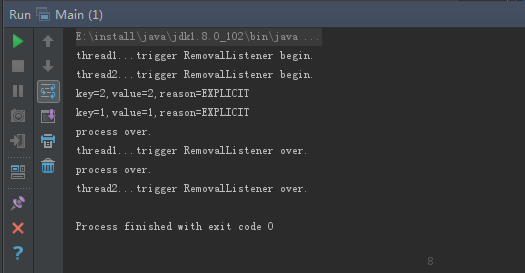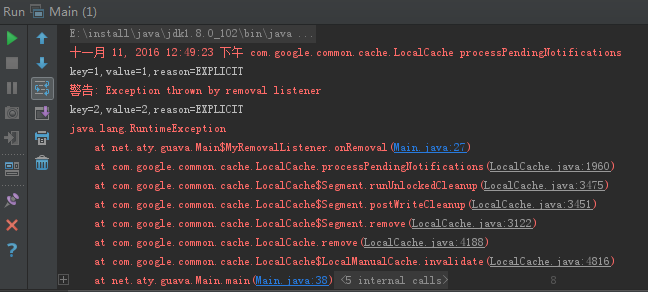Guava Cache 数据变化实现回调的监听器RemovalListener
当我们需要在缓存被移除的时候,得到通知产生回调,并做一些额外处理工作。这个时候RemovalListener就派上用场了。
public class Main { // 创建一个监听器 private static class MyRemovalListener implements RemovalListener<Integer, Integer> { @Override public void onRemoval(RemovalNotification<Integer, Integer> notification) { String tips = String.format("key=%s,value=%s,reason=%s", notification.getKey(), notification.getValue(), notification.getCause()); System.out.println(tips); } } public static void main(String[] args) { // 创建一个带有RemovalListener监听的缓存 Cache<Integer, Integer> cache = CacheBuilder.newBuilder().removalListener(new MyRemovalListener()).build(); cache.put(1, 1); // 手动清除 cache.invalidate(1); System.out.println(cache.getIfPresent(1)); // null } }
使用invalidate()清除缓存数据之后,注册的回调被触发了

下面是只有主动删除数据使的回调
public class CacheConnection { public static RemovalListener<String, Connection> myRemovalListener = new RemovalListener<String, Connection>(){ @Override public void onRemoval(RemovalNotification<String, Connection> notification) { String tips = String.format("key=%s,value=%s,reason=%s in myRemovalListener", notification.getKey(), notification.getValue(), notification.getCause()); System.out.println(tips); //when expireAfterAccess to do if (notification.getCause().equals("EXPIRED") && notification.getValue() != null) { try { notification.getValue().close(); } catch (SQLException e) { System.out.printf("Exception in myRemovalListener:\n"); e.printStackTrace(); } System.out.printf("Remove %s in cacheConnection", notification.getKey()); } } }; public static Cache<String, Connection> cacheConnection = CacheBuilder.newBuilder() //设置cache的初始大小为20000,要合理设置该值 .initialCapacity(20000) //设置并发数为5,即同一时间最多只能有5个线程往cache执行写入操作 .concurrencyLevel(100) //设置cache中的数据在600秒没有被读写将自动删除 .expireAfterAccess(600, TimeUnit.SECONDS) //设置监听,当出现自动删除时的回调 .removalListener(myRemovalListener) //构建cache实例 .build(); public static Connection getCache(String key) { try { Connection var = cacheConnection.getIfPresent(key); return var; } catch (Exception e) { // TODO: handle exception System.out.println("the value of cacheConnection is null"); e.printStackTrace(); return null; } } public static void putCache(String key, Connection value) { cacheConnection.put(key, value); } }
RemovalNotification中包含了缓存的key、value以及被移除的原因RemovalCause。通过源码可以看出,移除原因与容量管理方式是相对应的。下面是具体的消息
public enum RemovalCause { /** * The entry was manually removed by the user. This can result from the user invoking * {@link Cache#invalidate}, {@link Cache#invalidateAll(Iterable)}, {@link Cache#invalidateAll()}, * {@link Map#remove}, {@link ConcurrentMap#remove}, or {@link Iterator#remove}. */ EXPLICIT { @Override boolean wasEvicted() { return false; } }, /** * The entry itself was not actually removed, but its value was replaced by the user. This can * result from the user invoking {@link Cache#put}, {@link LoadingCache#refresh}, {@link Map#put}, * {@link Map#putAll}, {@link ConcurrentMap#replace(Object, Object)}, or * {@link ConcurrentMap#replace(Object, Object, Object)}. */ REPLACED { @Override boolean wasEvicted() { return false; } }, /** * The entry was removed automatically because its key or value was garbage-collected. This * can occur when using {@link CacheBuilder#weakKeys}, {@link CacheBuilder#weakValues}, or * {@link CacheBuilder#softValues}. */ COLLECTED { @Override boolean wasEvicted() { return true; } }, /** * The entry's expiration timestamp has passed. This can occur when using * {@link CacheBuilder#expireAfterWrite} or {@link CacheBuilder#expireAfterAccess}. */ EXPIRED { @Override boolean wasEvicted() { return true; } }, /** * The entry was evicted due to size constraints. This can occur when using * {@link CacheBuilder#maximumSize} or {@link CacheBuilder#maximumWeight}. */ SIZE { @Override boolean wasEvicted() { return true; } }; /** * Returns {@code true} if there was an automatic removal due to eviction (the cause is neither * {@link #EXPLICIT} nor {@link #REPLACED}). */ abstract boolean wasEvicted(); }
监听器使用很简单,有几个特点需要注意下:
1、默认情况下,监听器方法是被同步调用的(在移除缓存的那个线程中执行)。如果监听器方法比较耗时,会导致调用者线程阻塞时间变长。下面这段代码,由于监听器执行需要2s,所以main线程调用invalidate()要2s后才能返回。
public class Main { // 创建一个监听器 private static class MyRemovalListener implements RemovalListener<Integer, Integer> { @Override public void onRemoval(RemovalNotification<Integer, Integer> notification) { String tips = String.format("key=%s,value=%s,reason=%s", notification.getKey(), notification.getValue(), notification.getCause()); System.out.println(tips); try { // 模拟耗时 Thread.sleep(2000); } catch (InterruptedException e) { e.printStackTrace(); } } } public static void main(String[] args) { // 创建一个带有RemovalListener监听的缓存 final Cache<Integer, Integer> cache = CacheBuilder.newBuilder().removalListener(new MyRemovalListener()).build(); cache.put(1, 1); cache.put(2, 2); System.out.println("main...begin."); cache.invalidate(1);// 耗时2s System.out.println("main...over."); } }
解决这个问题的方法是:使用异步监听RemovalListeners.asynchronous(RemovalListener, Executor)。
public class Main { // 创建一个监听器 private static class MyRemovalListener implements RemovalListener<Integer, Integer> { @Override public void onRemoval(RemovalNotification<Integer, Integer> notification) { String tips = String.format("key=%s,value=%s,reason=%s", notification.getKey(), notification.getValue(), notification.getCause()); System.out.println(tips); try { // 模拟耗时 Thread.sleep(2000); } catch (InterruptedException e) { e.printStackTrace(); } } } public static void main(String[] args) { RemovalListener<Integer, Integer> async = RemovalListeners.asynchronous(new MyRemovalListener(), Executors.newSingleThreadExecutor()); // 创建一个带有RemovalListener监听的缓存 final Cache<Integer, Integer> cache = CacheBuilder.newBuilder().removalListener(async).build(); cache.put(1, 1); cache.put(2, 2); System.out.println("main...begin."); cache.invalidate(1);// main线程立刻返回 System.out.println("main...over."); } }
2、创建cache的时候只能添加1个监听器,这个监听器对象会被多个线程共享,所以如果监听器需要操作共享资源,那么一定要做好同步控制。下面这段代码可以看出:2个线程会交替执行监听器的发方法。
public class Main { // 创建一个监听器 private static class MyRemovalListener implements RemovalListener<Integer, Integer> { @Override public void onRemoval(RemovalNotification<Integer, Integer> notification) { String tips = String.format("key=%s,value=%s,reason=%s", notification.getKey(), notification.getValue(), notification.getCause()); System.out.println(tips); try { // 模拟耗时 Thread.sleep(2000); } catch (InterruptedException e) { e.printStackTrace(); } System.out.println("process over."); } } public static void main(String[] args) { // 创建一个带有RemovalListener监听的缓存 final Cache<Integer, Integer> cache = CacheBuilder.newBuilder().removalListener(new MyRemovalListener()).build(); cache.put(1, 1); cache.put(2, 2); new Thread(new Runnable() { @Override public void run() { System.out.println("thread1...trigger RemovalListener begin."); cache.invalidate(1); System.out.println("thread1...trigger RemovalListener over."); } }).start(); new Thread(new Runnable() { @Override public void run() { System.out.println("thread2...trigger RemovalListener begin."); cache.invalidate(2); System.out.println("thread2...trigger RemovalListener over."); } }).start(); } }

3、监听器中抛出的任何异常,在被记录到日志后,会被guava丢弃,不会导致监听器不可用。下面这段代码可以看到:监听器中抛出的异常只是被记录了(打印到了控制台),并没有导致JVM退出,之后缓存被移除一样可以再次触发。
public class Main { // 创建一个监听器 private static class MyRemovalListener implements RemovalListener<Integer, Integer> { @Override public void onRemoval(RemovalNotification<Integer, Integer> notification) { String tips = String.format("key=%s,value=%s,reason=%s", notification.getKey(), notification.getValue(), notification.getCause()); System.out.println(tips); throw new RuntimeException(); } } public static void main(String[] args) { // 创建一个带有RemovalListener监听的缓存 final Cache<Integer, Integer> cache = CacheBuilder.newBuilder().removalListener(new MyRemovalListener()).build(); cache.put(1, 1); cache.put(2, 2); cache.invalidate(1); cache.invalidate(2); } }

学习:https://blog.csdn.net/zhangjikuan/article/details/76408578





